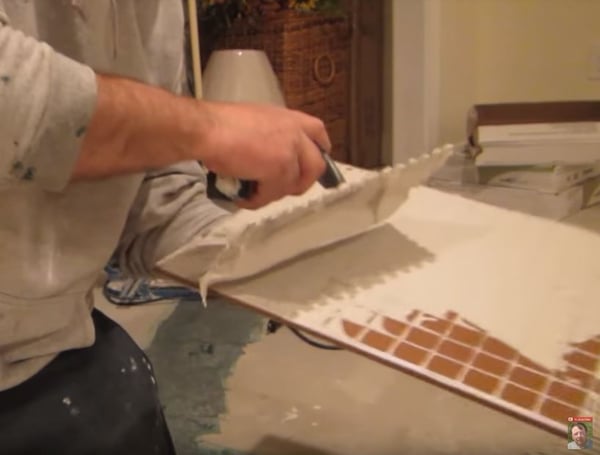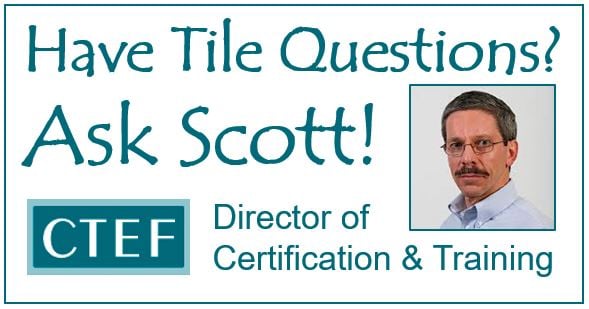
Do you back butter your tile?
Back buttering tile is a highly opinionated and widely debated topic among tile installers. Although it's recommended for natural stone tile, it's not always necessary or required to get adequate mortar coverage on ceramic and porcelain tile. So, how important is it?
To begin this discussion, we first need to define several words. According to the NTCA Reference Manual:
- Back butter is defined as, “the spreading of a bond coat to the backs of ceramic tile just before the tile is placed.”
- Bond is defined as, “The adherence of one material to another.”
- Coverage is defined as, “A measure of the amount of material required to cover a given surface.”
According to the CTEF Certified Tile Installer Manual, Transfer is defined as, “The required adhesion of a bonding material to the tile.”
Three Functions of Back Buttering
Most installers would agree that back buttering or back parging a tile places a thin layer of mortar on the back of the tile using the flat side of a trowel. This coating performs several functions.
1. Increases bond strength of the mortar
Primarily, it promotes the increased bond strength of the mortar to the back of the tile by keying or burning the mortar into the tile surface.
2. Fills voids on the back of the tile
Secondly, it fills the voids created by the embossed pattern on the back of the tile which creates a flat plane.
3. Can fill inherent tile warpage
Lastly, it can fill the inherent warpage of the tile (as long as the maximum mortar thickness designated by the manufacturer has not been exceeded).
What Else Does Back Buttering Do?
Mark Heinlein CTI #1112 and National Tile Contractors Association Training Director and Technical Trainer / Presenter explains back buttering as follows:
For ceramic or porcelain tile of any size, back buttering (also known regionally as “Keying In”, “Burning”, “Back Parging,” etc.) promotes the transfer of the bonding material to the back of the tile.
Back buttering is not required to achieve the necessary coverage and support. Coverage and support are achieved by using an appropriate trowel notch size and shape, directional troweling technique, and mortar selection and mixing.
>> See How to Correctly Trowel Mortar When Installing Tile?
>> See How To Select the Right Trowel Notch To Obtain the Required Mortar Coverage
>> See Getting the Coverage You Need Under Large Wall Tile
Back Buttering: not a requirement
In Why Do You Need Expansion Joints When Installing Tile?, I addressed back buttering as follows:
You are also correct that back buttering the tile will increase the bond of the mortar to the back of the tile, but according to the ANSI Specifications, back buttering is not a requirement.
ANSI A108.5 section 2.5.3 states:
“Average contact area shall be not less than 80% except on exterior or shower installation where contact area shall be 95% when not less than three tiles or tile assemblies are removed for inspection. The 80% or 95% coverage shall be sufficiently distributed to give full support of the tile.”
As you might imagine, it's critically important for the installer to periodically remove a tile to ensure that s/he is getting an adequate bond. If removing an occasional tile isn't practiced, an installer should reconsider the reason for not doing so.
Let's explore this in greater detail.
Back Buttering and Natural Stone Tile
As we mentioned above, back buttering is recommended for natural stone tiles to ensure all the voids are filled.
You'll find specific language that supports this statement in the "Mortar Application and Coverage" section found on page 35 of the 2018 edition of the Tile Council of North America (TCNA) Handbook for Ceramic, Glass, and Stone Tile Installation.
>> See The TCNA Handbook for Ceramic, Glass, and Stone Tile Installation
It states,
“Mortar coverage must be sufficient to prevent cracks in the stone resulting from voids in the setting bed. In dry and wet areas, the minimum coverage is 95% with no voids exceeding 2 square inches and no voids within 2” of tile corners. All corners and edges of the stone tiles must be fully supported, and back parging, or back buttering, is recommended in all areas. Coating the back of the tile, however, does not constitute coverage, which is the area where the mortar makes contact with the tile and the substrate.”
Here we see that the Handbook actually states that back buttering does not constitute or establish coverage. Using the appropriate trowel and placing an adequate amount of mortar between the substrate and the underside of the tile will provide the required 80% or 95% coverage as seen above in ANSI A108.5.
Back Buttering Tile Can Be Effective
Although not necessary for tile coverage, back buttering can be effective by increasing the bond of the mortar to the back of the tile which is an excellent benefit.
However, there is more to this process which we will see in the following paragraphs.
How to Back Butter Tile Correctly
For tips on how to back butter, we can't imagine a better resource than Sal DiBlasi to show you how in this 1:26 minute video titled "How to Back Butter a Tile":
Is There a Difference Between Coverage and Transfer?
The short answer is yes.
Adequate Coverage
The above definition of coverage was the measure of the amount of material required to cover a given surface. Using the appropriate trowel (which may be different than the one you are currently using or have seen) can provide the amount of mortar necessary to cover the back of the tile, yielding the required bond.
However, several other issues now come into play.
- In order to obtain the needed transfer (and bond) to the back of the tile, the mortar must be fresh, meaning not skinned over, and having enough moisture to initiate a bond to the back of the tile.
Coverage That Doesn't Transfer
Now here comes the tough one. Is it possible to have coverage and not transfer?
The answer again is yes.
If there is enough mortar to bond the tile and the tile is moved back and forth, as in the Trowel and Error video, coverage is attainable.
- But if the mortar has skinned over due to a dry substrate, windy site conditions, or high temperatures, the mortar will not transfer to the back of the tile and establish a good bond.
What if the Ridges Are Not Collapsed Into the Valleys?
For this process to work there are several things that must occur.
- The tile must be moved back and forth perpendicularly to the straight line troweling which causes the ridges to fall into the valleys provided by the trowel.
- Not moving the tile back and forth, allows the straight line troweling to remain which can yield less than 50% coverage.
To prove this point, back butter the tile with gray thin set mortar while keying in the substrate with the flat side of the trowel and combing the mortar with the notched side of the trowel in straight lines with white thin set mortar. Move the tile as seen in the Trowel and Error video, wait a week, and remove the tile. Check your results. You may be surprised by what you see or don’t see.

Questions About the Importance of Back Buttering Tile?
So, do you back butter your tile? Why or why not?
I am not saying that back buttering is not beneficial for bonding tile to the substrate, but we need to understand what it does and does not do. Enjoy the upcoming debate. It should be a really good one.
Thanks for reading!
Scott
Note: We originally published this article on 10/16/2018, and have updated it.

